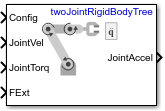Forward Dynamics
Joint accelerations given joint torques and states
Libraries:
Robotics System Toolbox /
Manipulator Algorithms
Description
The Forward Dynamics block computes joint accelerations for a robot model given a robot state that is made up of joint torques, joint states, and external forces. To get the joint accelerations, specify the robot configuration (joint positions), joint velocities, applied torques, and external forces.
Specify the robot model in the Rigid body tree parameter as a
rigidBodyTree object, and set the
Gravity property on the
object. You can also import a robot model from an URDF (Unified Robot Description
Format) file using importrobot.
Examples
Ports
Input
Output
Parameters
Extended Capabilities
Version History
Introduced in R2018a
See Also
Blocks
- Inverse Dynamics | Get Jacobian | Gravity Torque | Joint Space Mass Matrix | Velocity Product Torque | Get Transform

